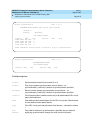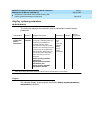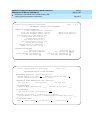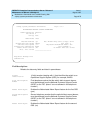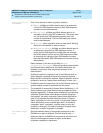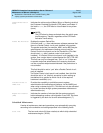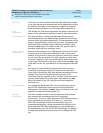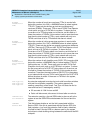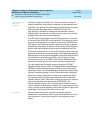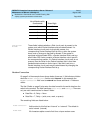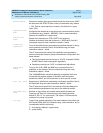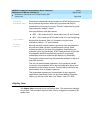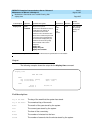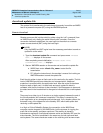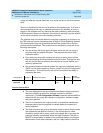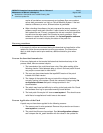
DEFINITY Enterprise Communications Server Release 6
Maintenance for R6vs/si
555-230-127
Issue 1
August 1997
Maintenance Commands and Trouble-Clearing Aids
Page 8-83display system-parameters maintenance
8
DSO Loop-Around
Test Call
Extension
Extension number for the test call. This test extension number is
used to establish a loop-around connection on the selected trunk.
The DSO Loop-Around Test Call feature is used primarily for testing
DSO channels associated with non-ISDN-PRI trunks. The
loop-around is activated by dialing the test extension number.
Multiple DSO Loop-Around connections can be set up by placing
multiple calls to the loop-around extension.
The DS0 Loop Around feature provides a loop around connection
for incoming non-ISDN DS1 trunk data calls. This feature is similar
to the far-end loop around connection provided for the ISDN Test
Call feature. This DS0 loop around is provided primarily to allow a
network service provider to perform facility testing at the DS0 level
before video teleconferencing terminals are installed at the PBX.
The feature is activated on a call-by-call basis by dialing a test call
extension specified on the second page of the System Parameters
Maintenance form. No special hardware is required. When the test
call extension is received by the PBX, a non-inverting, 64 kbps
connection is set up on the PBX’s Time Division Multiplexed bus.
More than one loop around call can be active at the same time.
For calls routed over the public network using the ACCUNET
Switched Digital Service (SDS) or Software Defined Data Network
(SDDN), the data transmission rate is 56 Kbps, since robbed bit
signaling is used. For calls established over a private network using
common channel signaling, the full 64 kbps data rate is available.
When the incoming trunk group is used only for data calls (SDS),
the Communications Type on the associated Trunk Group form
should be set to “data.” When the incoming trunk group is used for
robbed bit alternate voice and/or data (SDN/SDDN), the
Communications Type on the Trunk Group form should be set to
“rbavd” (robbed bit alternate voice data). For private network trunks
using common channel signaling, the Communications Type on the
associated Trunk Group form can be set to “avd.”
Loss Plan
Use only when extra loss is required to maintain quality of
transmission on conference calls. Leave this field blank if no extra
loss is required. If extra loss is required, enter digits as shown
below.



